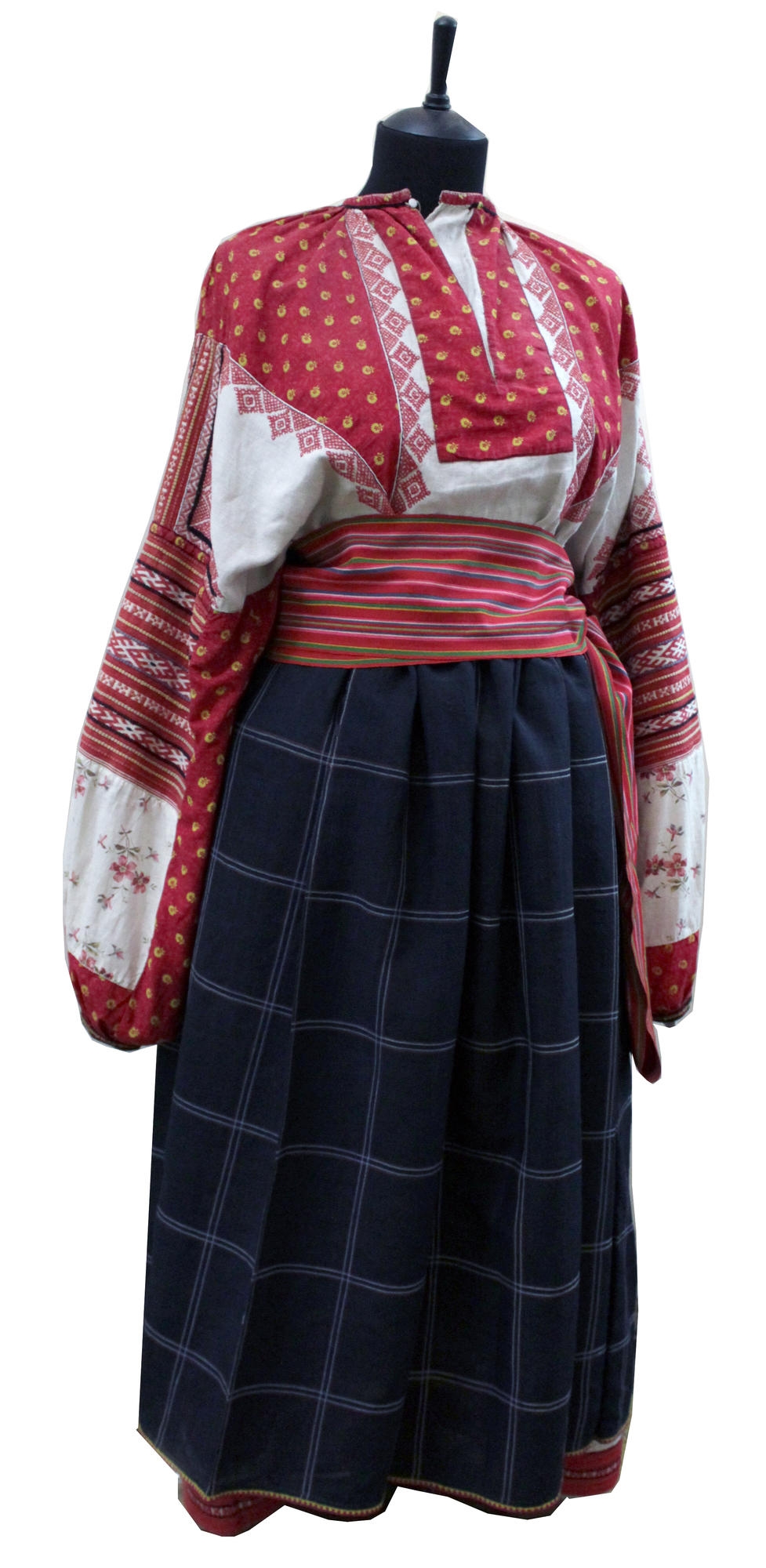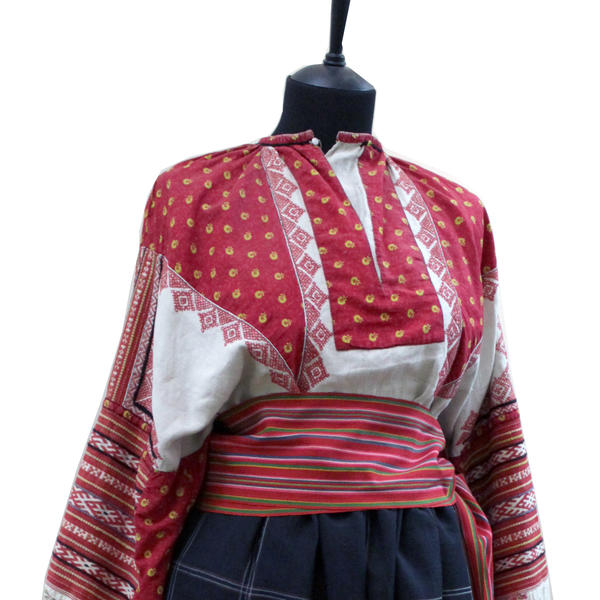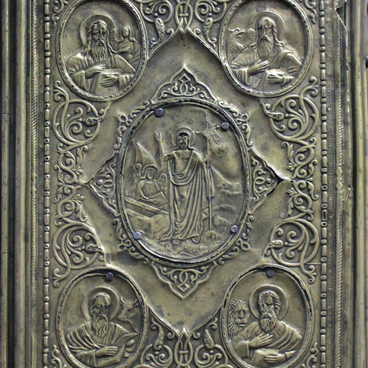Researchers attribute the costumes of the Tambov Governorate to traditional South Russian culture. Its representatives lived in the Black Earth region, limited by the Desna River in the west, Sura in the east, Oka in the north, and stretching through Khoper and Don to the foothills of the North Caucasus. Since the 17th century, this region was inhabited mainly by natives of the Don region or of the Left-Bank Ukraine, and servicemen from the north who came to guard the southern borders.
Gradually, the traditions of the immigrants from different Russian cities and villages were mixed with the traditions of the Mordovians, the region’s indigenous population. However, the immigrants’ native clothing style became more popular. Peasant women dressed differently in different villages, and their costumes showed from what part of the country they came to the Tambov region and what were their occupations before.
Tambov peasant women wove their clothing fabrics themselves. They wove linen or hemp canvas, dressed sheepskins or made broadcloth, a very dense fabric of woolen fibers. The motley, a coarse cotton cloth woven from dyed multi-colored threads, as well as multi-colored printed cloths were popular. Craftswomen also made fabric prints themselves. They carved a pattern on a wooden board and applied paint to it, to make a stamp. Then they placed the stamp on the fabric and beat it with a wooden hammer, or mallet. They carved a separate stamp for each color. Sometimes, peasant women added factory-made fabrics to the homespun materials; they used inexpensive chintz, sateen, bright red cotton fabric, or cheap woolen cloth.
This peasant costume belonged to an adult woman. It is based on a long-sleeved homespun canvas long shirt worn next to the skin. Women wore a shirt both at home and outside. Married peasant women of the Tambov region usually wore shirts with biased poliki made of bright red cotton fabric or red sateen. The poliki were trapeze-shaped inserts that connected the parts of the shirt on the shoulders and made it visually wider and finer looking. Craftswomen decorated their shirts with embroidery or wove a red pattern on the hem, collar, upper part of the sleeve and wrist.
If a Tambov peasant woman was betrothed or married, she put over her shirt a ponyova: a wide and long homespun woolen skirt. Tambov region women wore ponyova skirts sewn from three pieces of checkered wool, connected with a strip of plain blue or black fabric. At the waist, the ponyova was gathered with a cord or belt. Sometimes peasant women put on a long sash. Ponyova skirts were usually dark, with a pattern made by strips of multi-colored red, yellow, and white threads. The festive ponyovas were decorated with ribbons and lace.
Sometimes a peasant woman wore a camisole over her shirt and ponyova skirt. It was a long and wide overcoat that looked like a tunic. It was richly decorated with red cotton or woolen cloth, and patterns were woven on it. The camisole was shorter than the shirt and the skirt, so the hem of the skirt was partly visible. At the time, married peasant women wore scarves as everyday headdress, while girls wore headbands.
Gradually, the traditions of the immigrants from different Russian cities and villages were mixed with the traditions of the Mordovians, the region’s indigenous population. However, the immigrants’ native clothing style became more popular. Peasant women dressed differently in different villages, and their costumes showed from what part of the country they came to the Tambov region and what were their occupations before.
Tambov peasant women wove their clothing fabrics themselves. They wove linen or hemp canvas, dressed sheepskins or made broadcloth, a very dense fabric of woolen fibers. The motley, a coarse cotton cloth woven from dyed multi-colored threads, as well as multi-colored printed cloths were popular. Craftswomen also made fabric prints themselves. They carved a pattern on a wooden board and applied paint to it, to make a stamp. Then they placed the stamp on the fabric and beat it with a wooden hammer, or mallet. They carved a separate stamp for each color. Sometimes, peasant women added factory-made fabrics to the homespun materials; they used inexpensive chintz, sateen, bright red cotton fabric, or cheap woolen cloth.
This peasant costume belonged to an adult woman. It is based on a long-sleeved homespun canvas long shirt worn next to the skin. Women wore a shirt both at home and outside. Married peasant women of the Tambov region usually wore shirts with biased poliki made of bright red cotton fabric or red sateen. The poliki were trapeze-shaped inserts that connected the parts of the shirt on the shoulders and made it visually wider and finer looking. Craftswomen decorated their shirts with embroidery or wove a red pattern on the hem, collar, upper part of the sleeve and wrist.
If a Tambov peasant woman was betrothed or married, she put over her shirt a ponyova: a wide and long homespun woolen skirt. Tambov region women wore ponyova skirts sewn from three pieces of checkered wool, connected with a strip of plain blue or black fabric. At the waist, the ponyova was gathered with a cord or belt. Sometimes peasant women put on a long sash. Ponyova skirts were usually dark, with a pattern made by strips of multi-colored red, yellow, and white threads. The festive ponyovas were decorated with ribbons and lace.
Sometimes a peasant woman wore a camisole over her shirt and ponyova skirt. It was a long and wide overcoat that looked like a tunic. It was richly decorated with red cotton or woolen cloth, and patterns were woven on it. The camisole was shorter than the shirt and the skirt, so the hem of the skirt was partly visible. At the time, married peasant women wore scarves as everyday headdress, while girls wore headbands.


